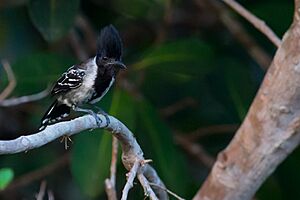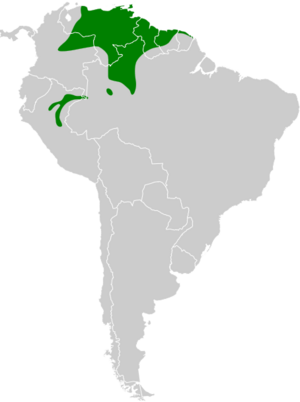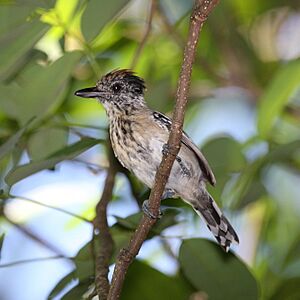Black-crested antshrike facts for kids
Quick facts for kids Black-crested antshrike |
|
|---|---|
 |
|
| Male | |
| Conservation status | |
| Scientific classification | |
| Genus: |
Sakesphorus
|
| Species: |
canadensis
|
 |
|
| Synonyms | |
|
Lanius canadensis Linnaeus, 1766 |
|
The black-crested antshrike (Sakesphorus canadensis) is a cool passerine bird, which means it's a type of songbird. It belongs to the "typical antbirds" family. You can find this bird in warm, tropical parts of South America, including places like Trinidad, Colombia, Venezuela, the Guianas, Brazil, and Peru.
Contents
About the Black-crested Antshrike
How Scientists Named This Bird
In 1760, a French zoologist named Mathurin Jacques Brisson wrote about the black-crested antshrike. He thought it came from Canada by mistake! He gave it a French name, La Pie-Griesche de Canada.
Later, in 1766, the famous Swedish naturalist Carl Linnaeus updated his big book, Systema Naturae. He added many species, including this bird. Linnaeus gave it the scientific name Lanius canadensis. Today, this bird is placed in a group called Sakesphorus. This group was created by a British bird expert, Charles Chubb, in 1918.
Different Types of Black-crested Antshrikes
Scientists sometimes disagree on how to group animals. For the black-crested antshrike, most bird groups recognize six different subspecies. Subspecies are like different versions of the same animal that live in different places and have small differences.
Here are the six subspecies:
- S. c. pulchellus
- S. c. intermedius
- S. c. fumosus
- S. c. trinitatis
- S. c. canadensis
- S. c. loretoyacuensis
However, one important bird organization, BirdLife International, thinks that S. c. pulchellus is actually its own separate species. They call it the "streak-fronted antshrike." For this article, we'll follow the idea that it's all one species with six subspecies.
What Does the Black-crested Antshrike Look Like?
This bird is about 14 to 18 cm (5.5 to 7.1 in) long, which is about the length of a small ruler. It weighs between 20 to 28 g (0.71 to 0.99 oz), which is lighter than a few quarters.
Both male and female black-crested antshrikes have a cool, shaggy crest of feathers on their heads. But they do look different, which is called sexual dimorphism.
Male Black-crested Antshrike
Adult males of the most common type (called the nominate subspecies, S. c. canadensis) have a black head, throat, and the middle of their chest. They have a white band on the back of their neck. Their upper body is a cinnamon-brown color. Their wings and tail are black, with white edges on the feathers and white spots on the tips of their outer tail feathers. The sides of their chest and their belly are whitish-gray.
Female Black-crested Antshrike
Adult females have a reddish-brown crown (top of the head) and a grayish face. The back of their neck and sides of their neck are cinnamon-colored. Their upper body is cinnamon-brown, just like the male's. Their wings and tail are brownish-black with white edges and tips. Their throat is whitish, and their chest is cinnamon with dark streaks. Their belly is a whitish color with a hint of buff. Young males look a lot like adult females.
How Subspecies Differ in Appearance
The different subspecies have slight variations in their colors and patterns:
- S. c. pulchellus: Males have white streaks on their black crown and throat. Females are a lighter color than the main type.
- S. c. fumosus: These birds are generally darker. Males have almost black upper parts and very little white on their neck. Females are dark with heavy streaks on their chest.
- S. c. loretoyacuensis: These are similar to fumosus but males have more white on their neck and underparts.
Where Does the Black-crested Antshrike Live?
The black-crested antshrike lives in different, separate areas, which is called a "disjunct distribution." You can find them in various parts of South America.
Specific Locations for Subspecies
- S. c. pulchellus: Lives in northern Colombia and extreme northwestern Venezuela.
- S. c. intermedius: Found in eastern Colombia and much of Venezuela, extending into northern Brazil.
- S. c. fumosus: Lives in southwestern Venezuela.
- S. c. trinitatis: Found in northeastern Venezuela, Guyana, and on the island of Trinidad.
- S. c. canadensis: Lives in Suriname and coastal French Guiana.
- S. c. loretoyacuensis: Found in southeastern Colombia, northwestern Brazil, and northeastern Peru.
Their Favorite Places to Live
These birds like to live in different kinds of forests and bushy areas. This includes dry forests, savanna woodlands, and forests along rivers (called gallery forest). They also live at the edges of flooded forests, like igapó and várzea forests. Sometimes, you can even find them in mangrove swamps and sandy areas near the Caribbean coast.
Black-crested antshrikes usually stay in the lower and middle parts of the forest. They can also be seen in gardens and city parks! They typically live at elevations up to 900 m (3,000 ft) high, but sometimes lower in places like Colombia and Venezuela.
How Does the Black-crested Antshrike Behave?
Staying in One Place
The black-crested antshrike is thought to live in the same area all year round. It doesn't usually migrate to other places.
What Do They Eat?
These birds eat a variety of things! Their main diet includes many kinds of insects and other arthropods (like spiders). They also sometimes eat small lizards and fruit.
They usually look for food alone or in pairs. Sometimes, they join groups of different bird species that are all feeding together. They typically search for food from the ground up to about 15 m (50 ft) high. They hop through thick plants, picking up prey from leaves, stems, and branches. They might even jump a little to catch something or drop to the ground.
How Do They Raise Their Young?
The breeding season for the black-crested antshrike changes depending on where they live. For example, in Colombia and Venezuela, it's from June to September. In Guyana, it's March to May.
Their nest is shaped like a cup. It's made from grass and other plant materials, often hanging in a fork of a tree branch. Usually, they lay two eggs. In one study in Suriname, the eggs hatched after 14 days. Both the male and female birds take turns sitting on the eggs and feeding the baby birds during the day. Only the female sits on the nest at night.
What Do They Sound Like?
The main song of most black-crested antshrikes is a series of about 10 to 15 notes. It starts flat and sounds a bit like a complaint, then gets higher in pitch and speeds up quickly. The "streak-fronted" subspecies (S. c. pulchellus) has a similar song, but it's slower and lower-pitched. The last few notes drop even lower.
Their calls sound similar across all the different subspecies. They include a complex, downward-sloping note that sounds "squeezed out." They also make abrupt "chup" notes that are repeated often, and a "rattle call" that starts with a long, clear note.
How Is the Black-crested Antshrike Doing?
The IUCN (International Union for Conservation of Nature) looks at how many animals are left in the wild. They follow the idea that the "streak-fronted" and "black-crested" antshrikes are separate.
Both types are listed as "Least Concern." This means they are not currently in danger of disappearing. Scientists don't know exactly how many there are, but they believe the numbers might be slowly going down. However, no immediate big threats have been found. This bird is considered common in the places where it lives. Because it can live in many different types of habitats, it's somewhat protected from problems. Still, some local groups, especially those in dry forests, might be more sensitive to changes.



